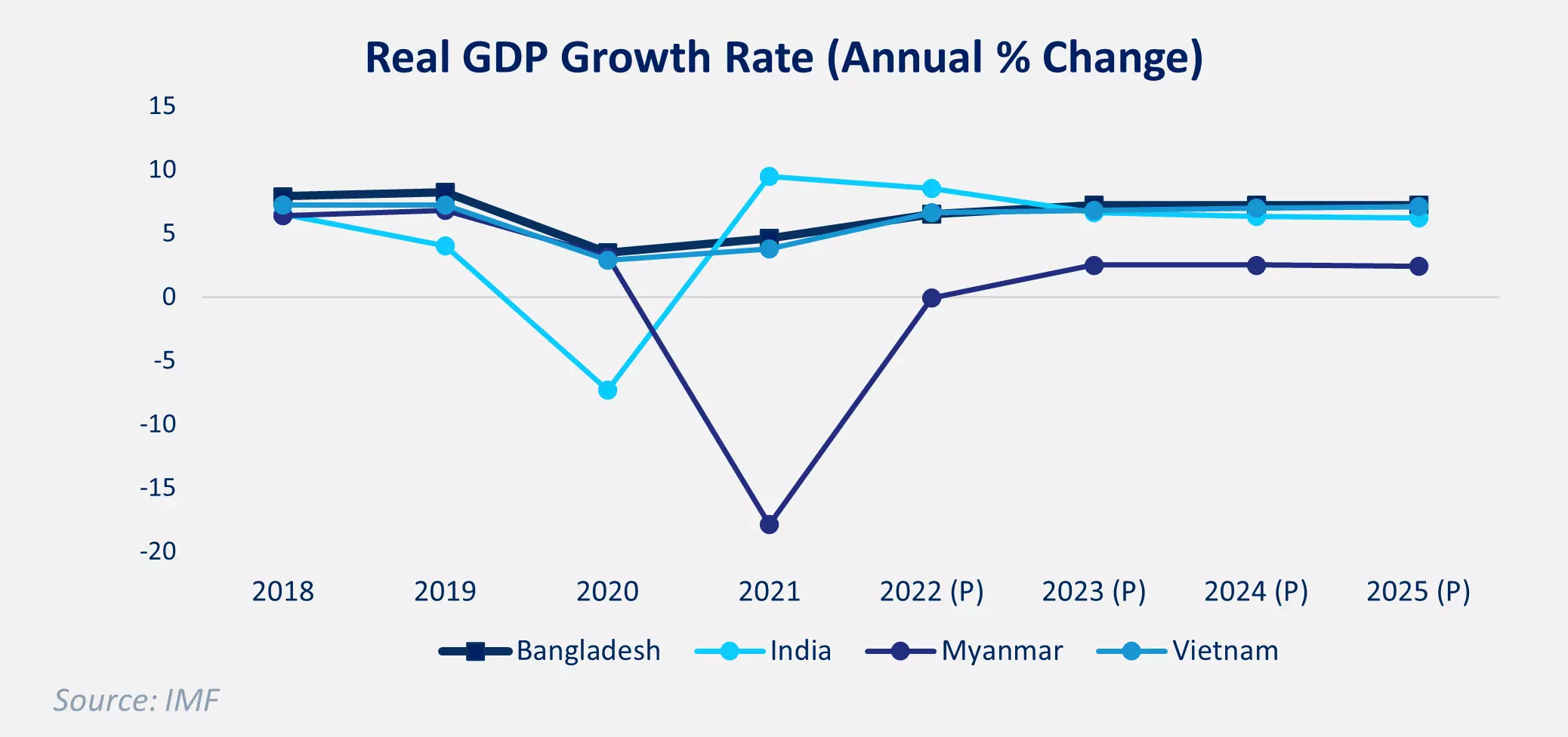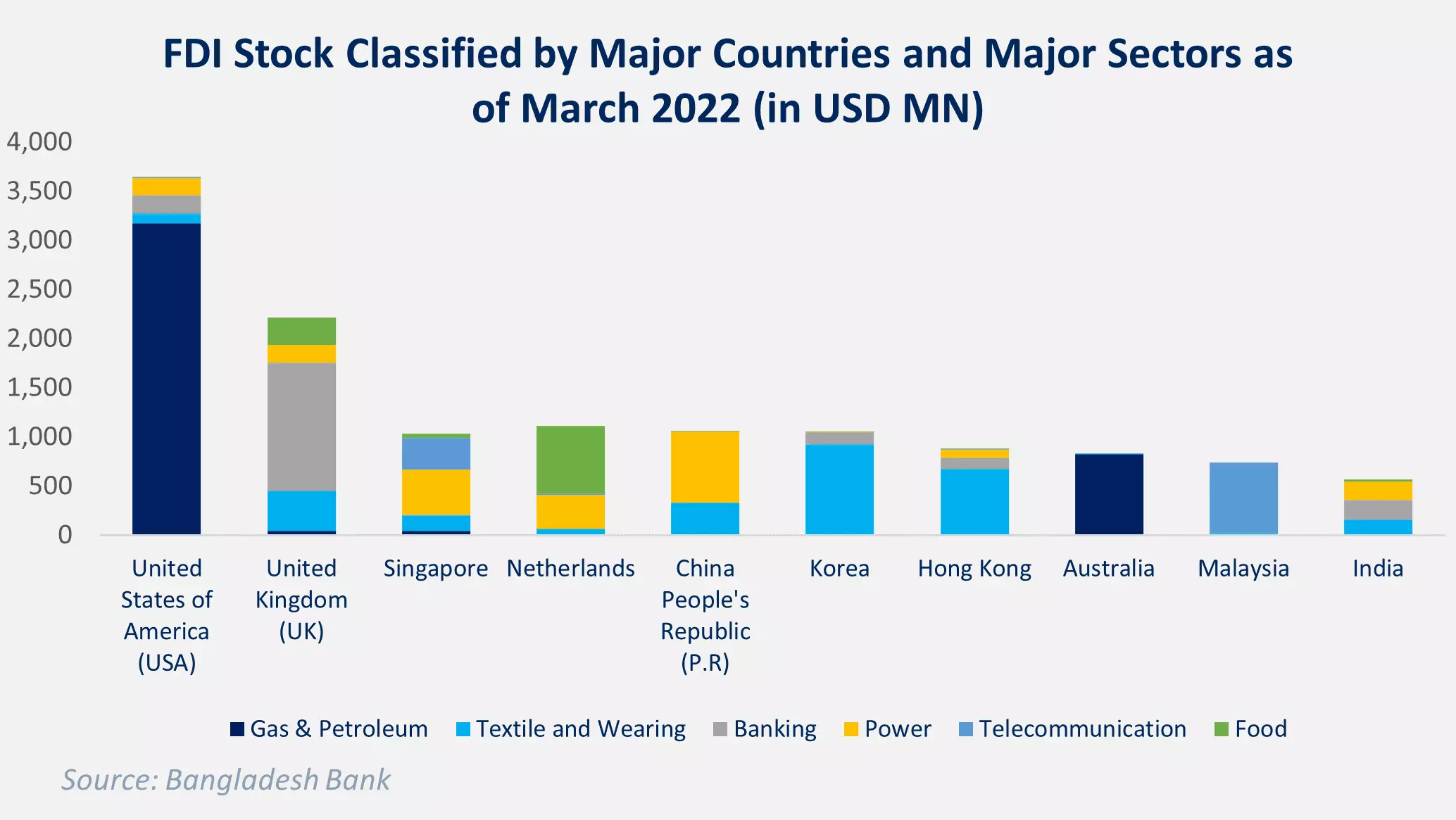GET IN TOUCH
- Please wait...
![How Bangladesh’s Investment Climate Is Responding to Global Turmoil [Part 1]](https://www.lightcastlebd.com/wp-content/uploads/2023/05/investment-climate.webp)
Bangladesh’s rise from the ruins of its war of independence, 50 years ago, has been nothing short of remarkable. In 2020, Bangladesh surpassed India’s, GDP per capita, and is now the second-largest economy in Southeast Asia as well as the 41st largest in the world. The middle and affluent class in the country is growing fast and is expected to surpass 30 million by 2025, like the current population of Malaysia.
The country will finally be graduating to Middle-Income Country status in 2026 and will no longer be considered a least developed nation. This milestone is expected to galvanize international investors’ confidence and pave the way for a progressive business environment and increased flow of investments, which will boost local employment opportunities and revenue collection in the country. [1]
During the pandemic, India and Myanmar suffered from an economic downturn, while Bangladesh maintained a modest growth rate that is predicted to increase steadily over the next 5 years. Despite high economic dependence on the apparel industry and inward remittances, Bangladesh did not falter, due to active measures to support both sectors, which led to mitigated contraction and a strong resurgence. Overall, the country shattered its export record in FY 2021-22 surpassing 52 billion USD.

The foreign exchange reserve of Bangladesh grew at a CAGR of 8.6 per cent over the last 5 years, till FY 2020-21 to 46.4 billion USD. However, the forex reserve as of July 2022 went down to 39.49 billion USD. The sudden plunge was due to the growing expensive imports and fall in inward remittance that was precipitated by the ongoing Ukraine-Russia war. [2] On the other hand, Bangladesh’s FDI in 2021 was 2.89 billion USD and it grew at a CAGR of 7.6 per cent in the last 5 years. Total FDI stock as of March 2022 shows that USA, UK, Singapore, and the Netherlands had the highest investments in major sectors among all the countries. [3]

Some of the major foreign direct acquisitions and mergers include:
Now having put the pandemic behind it, the country is ready to grow aggressively in the next five years. 6.7 per cent growth is expected in FY 2022-23 alone. [5] Strong fundamentals and strategic public investments are helping build national resilience and mitigate crises such as fallout from the Russia-Ukraine war and climate change. Projections say the country will become the 34th largest economy by 2026, followed by 24th spot in 2036. [6]
Bangladesh’s foreign direct investment has been low over the past 5 years when compared to near-profile countries. In 2020, FDI inflow of the country stood at 2.6 billion USD while that of Vietnam and Indonesia were 15.8 billion USD and 18.6 billion USD.
Despite strong fundamentals such as access to low-cost labour and tax incentives, ease of doing business and regulatory uncertainty have dampened investment in yesteryears. For instance, business permits and property registration involve long lead times compared to peer nations. Nevertheless, given that private investments are key to sustainable development, the 8 Five Year Plan (2020-2025) has initiated policies that tackle the challenge of mobilizing foreign direct investment head-on. [7]
This has led to the development of a One Stop Solution for investors, which covers 47 services through a digital portal hosted by the Bangladesh Investment Development Authority (BIDA). The platform is the outcome of the cooperation between 25 agencies and facilitates getting: Name Clearance and Company Registration, Trade License, e-TIN registration, VAT registration, MOHA security clearance, Electricity Connections, Industrial Registration with BIDA, IRC Recommendation, Visa recommendation, Office Permission for branch/liaison/representative office, NID verification, Remittance Approval, Land Use Clearance, Certificate of Origin, Environmental Clearance Certificate, etc. [8]
Bangladesh’s national budget FY 2022-23 has further incentivized the businesses this year. Source tax on raw materials have reduced by 3 per cent. On the other hand, corporate tax of listed and non-listed companies has been reduced by 2.5per cent every year since FY 2020-21. The current CT rate of 20 per cent for limited companies, matching the rate in Vietnam.

Start-up companies will have to pay an even lower tax of 0.1 per cent from 0.6 per cent starting this fiscal year. Furthermore, the government has announced a 10-year tax break for agro-processing, dairy and dairy products, baby food products, and agricultural equipment manufacturing. [9]
100per cent foreign ownership is allowed in majority of the sectors; however, local ownership is still required in logistics services including cargo and courier services, buying house and indenting agent, advertising agent, and for commercial educational institutions. The government revoked the 49 per cent maximum allowable shareholding limit on foreign e-commerce companies, allowing 100 per cent foreign ownership in 2020. [10] The pandemic has helped the e-commerce sector to grow by 25 per cent and is still growing strong. Additionally, investors can also enjoy tax holiday for ‘thrust’ sector projects initiated between July 1, 2019, and June 30, 2024, making this a particularly good time to invest in Bangladesh. The sectors include agriculture, apparel, ICT, pharmaceuticals, light engineering, jute and jute products, plastic, manpower export, tea, tourism, healthcare, and automobile manufacturing. [11]
These sectors are eligible for tax break of 90 per cent to 20 per cent for a period of 5 to 10 years. [12] Bangladesh Economic Zone Authority (BEZA) eased their policy on foreign nationals remitting their income. Foreign employees working in EZs are allowed to remit 75 per cent of their income. 100 special economic zones are also being built to attract both domestic and foreign investors. [13]
Symbolizing its ambitions, the country plans to facilitate the automobile industry with tax incentives and turn it to a regional hub for manufacturing by 2030. A one-time 100 per cent tax waiver for machinery imports for Complete Knocked Down (CKD) factories has been initiated. Manufacturers will also enjoy a total tax incidence not more than 10per cent if parts are sourced locally. Further tax rebates will be provided if 1 per cent of earnings is spent on R&D. EV assemblers and manufacturers will get a 10-year tax holiday while consumers will enjoy reduced registration fees. [14]
Bangladesh is set to graduate from a least developed country in 2026 and is to lose GSP facilities with major markets. Hence, new guidelines on RTAs and FTAs are being drafted to secure the interests of the country. The ministry is currently negotiating FTAs with 26 countries and 3 regional blocs. [15] Moreover, the country is planning to be a part of ASEAN due to its strong trade relationship with some of the regions in this bloc. [16] The foreign ministry has led a charm-offensive to develop bilateral and multilateral trade and investment relationships with countries in the G20. Gaining market access will not only improve the country with export upgradation and expansion of production capabilities.
The country’s apparel exports account for 84 per cent of the total exports and have been growing at an annual rate of 9.8 per cent. Bangladesh is the second largest exporter of garments, with a global market share of 6.4per cent. The world’s leading exporter, China is shifting towards the production of high-tech manufacturing, and this will allow Bangladesh to capture a bigger market share.
The government has set significant cash incentives and export subsidies for trade with different countries. [17] Garment exporters enjoy a 5 per cent cash incentive if apparel items are exported using locally procured raw materials like yarn and fabrics. 4 per cent additional cash incentives are offered if goods are shipped to non-traditional markets, which include all export destinations except the EU, Canada, and the US. [18]
Additionally, social development of workers including the provision of education and skills training is being implemented with the support of the Government, NGOs, and private sector partners. [19] The country exported 31.4 billion USD worth of apparel in FY 2020-21 while the current figure for FY 2021-22 stands at 42.6 billion USD, the highest ever in the country’s experience. [20]
The inflow of remittance in Bangladesh stood at 4.5 per cent of the GDP in FY 2021-22, however, it has reduced by 15 per cent from its preceding year. [21] The country’s skilled labour force is now in demand by nations in Africa and Southeast Asia including South Sudan and India. South Sudan is offering contract farming opportunities to address the continent’s food shortage supply. [22] The government is also providing a 2.5 per cent cash incentive for first time inward remittance through banking channels. [23] Remittance plays an essential role in the reduction of poverty in a country. A study conducted by ADB showed that a 1 per cent increase in international remittance can reduce the poverty gap ratio by 22.6per cent. [24] A record-breaking 24.7 billion USD worth of inward remittance was received in FY 2020-21. [21]
About 11.6 per cent of the GDP contribution is done by agriculture, forestry, and fishing in Bangladesh. [25] The sector employs nearly 40 per cent of the total labour force. With an annual growth rate 3.54 per cent, the sector is currently eyeing export possibilities in agro-processing. Products including fish, vegetables & fruits and processed snacks are the most heavily exported agro-processed products. Moreover, the government is providing tax incentives for industries engaged in biotechnology-based agro products, production of corn and income generated from poultry, fish feed, cattle farming etc. The 7.7 per cent growth rate of the industry will allow new opportunities in the packaged food industry, fisheries & seafood, halal food and processed fruits and vegetables. [17] In FY 2020-21, Bangladesh’s export earnings agricultural products crossed the 1 billion USD, a nearly 20 per cent increase from the previous fiscal year.
The pharmaceutical sector of Bangladesh is expected to grow at over 16 per cent and become a 6 billion USD industry by 2025. [26] Local companies have settled themselves better than other Lower and Middle-Income Countries (LMIC) of comparable population and economic standing as the import figures are lower than Nigeria and Vietnam. [27] Along with it, the country’s pharmaceutical exports are growing by 15 per cent and major destinations include USA, Australia, and EU. Foreign investors have the opportunity to address the growing demand for the generic segment and produce substitutes of imported drugs. The government is also providing reduced tax benefits for engagement in pharmaceuticals and 10 per cent export subsidy/ cash incentives on medicinal products. [17] Recently, Square Pharmaceuticals, has setup operations in Kenya and will be manufacturing and selling generic pharmaceutical medicine in Kenya for East African market. In part two of the analysis on the Investment Climate Status of Bangladesh, key sector-specific interventions in action will be discussed along with the persisting global challenges the country has to encounter.
This article was authored by Fahmid Kaisar, Business Consultant at LightCastle Partners, and, Tasnim Mustaque, Business Consultant at LightCastle Partners. For further clarifications, contact here: [email protected]
Our experts can help you solve your unique challenges
Stay up-to-date with our Thought Leadership and Insights